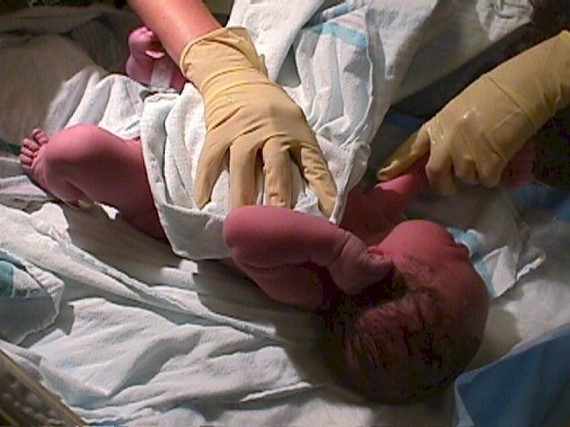Nurses can prevent evaporative heat loss in the newborn by:
Drying the baby after birth and wrapping the baby in a dry blanket.
Keeping the baby out of drafts and away from air conditioners.
Placing the baby away from the outside wall and the windows.
Warming the stethoscope and the nurse’s hands before touching the baby.
The Correct Answer is A
Drying the baby after birth and wrapping the baby in a dry blanket

This prevents evaporative heat loss, which occurs when water on the skin surface evaporates and cools the skin. Evaporative heat loss is especially significant in newborns because they are wet at birth and have a large surface area relative to their body mass.
Choice B is wrong because it addresses convective heat loss, which occurs when air currents blow over the skin and carry away heat.
Convective heat loss can be prevented by keeping the baby out of drafts and away from air conditioners.
Choice C is wrong because it addresses radiant heat loss, which occurs when heat radiates from the skin to cooler objects in the environment.
Radiant heat loss can be prevented by placing the baby away from the outside wall and the windows.
Choice D is wrong because it addresses conductive heat loss, which occurs when heat transfers from the skin to cooler objects in contact with the skin.
Conductive heat loss can be prevented by warming the stethoscope and the nurse’s hands before touching the baby.
Normal body temperature for a newborn is 36.5°C to 37.5°C (97.7°F to 99.5°F).
Nursing Test Bank
Naxlex Comprehensive Predictor Exams
Related Questions
Correct Answer is ["A","C","D","E","F"]
Explanation
A health history is a holistic assessment of all factors affecting a patient’s health status, including information about social, cultural, familial, and economic aspects of the patient’s life as well as any other component of the patient’s life style that affects health and well-being.
Choice B is wrong because physical assessment is not part of the health history, but a separate process of examining the patient’s body systems.
Choice A is correct because review of systems is a systematic method of collecting data on all body systems.
Choice C is correct because sexual history is an important aspect of the patient’s health that may affect their risk for sexually transmitted infections, reproductive health, and psychosocial well-being.
Choice D is correct because height, weight, BMI data are part of the biographical data that provide a baseline for comparing the patient’s characteristics to established norms for physical and emotional health.
Choice E is correct because diet and nutritional intake are relevant factors that influence the patient’s health status and may indicate potential problems such as malnutrition, obesity, or eating disorders.
Choice F is correct because family medical history provides information about the patient’s genetic risk for certain diseases and conditions that may affect their current or future health.
Correct Answer is ["B","D"]
Explanation
Sleepiness or fatigue and puffiness around the eyes are symptoms associated with hypothyroidism. Hypothyroidism is a condition where the thyroid gland does not produce enough thyroid hormones, which regulate the body’s metabolism and energy levels.
Choice A is wrong because weight loss is more likely to occur in hyperthyroidism, a condition where the thyroid gland produces too much thyroid hormones.
Choice C is wrong because diarrhea is also more likely to occur in hyperthyroidism, as the excess thyroid hormones speed up the digestive system.
Choice E is wrong because limited hair growth is not a specific symptom of hypothyroidism. Hair loss or thinning may occur in both hypothyroidism and hyperthyroidism, depending on the severity and duration of the condition.
Normal ranges for thyroid hormones are:
- TSH: 0.4 to 4.0 mIU/L
- T3: 100 to 200 ng/dL
- T4: 4.5 to 11.2 mcg/dL
Whether you are a student looking to ace your exams or a practicing nurse seeking to enhance your expertise , our nursing education contents will empower you with the confidence and competence to make a difference in the lives of patients and become a respected leader in the healthcare field.
Visit Naxlex, invest in your future and unlock endless possibilities with our unparalleled nursing education contents today
Report Wrong Answer on the Current Question
Do you disagree with the answer? If yes, what is your expected answer? Explain.
Kindly be descriptive with the issue you are facing.
